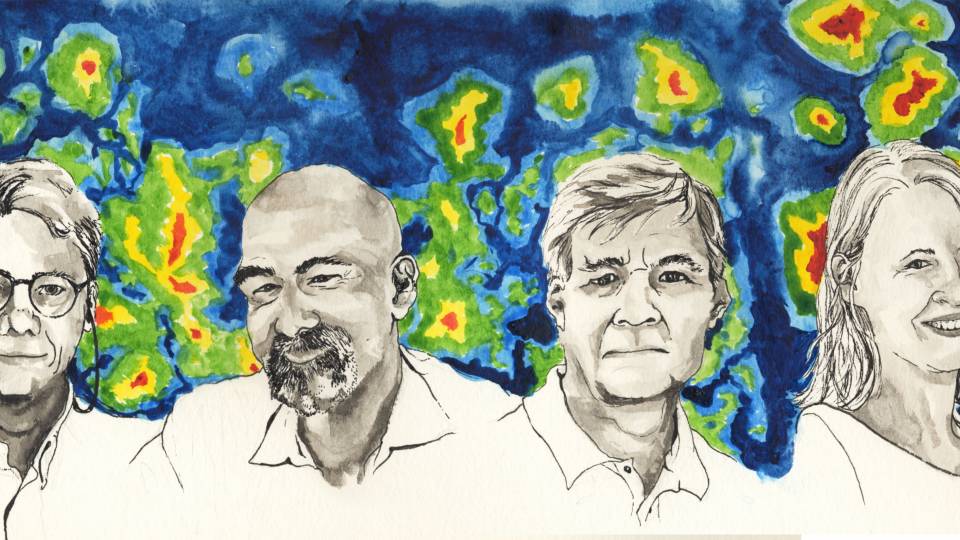pride and joy is about to leave home, see great sights and, if all goes well, send back reports that will change humankind's view of the universe.
It's not a graduation. It's a satellite launch.
On June 30, a team of Princeton scientists will be at Cape Canaveral to watch NASA launch a satellite carrying a powerful scientific instrument that Princeton played a major role in concieving, designing and building.
The great sight it is intended to glimpse is nothing less than the infancy of the universe. The satellite will measure something called cosmic microwave background radiation -- a faint trickle of energy that is essentially the echo of the Big Bang itself.
"We're getting a snapshot of what the universe looked like 300,000 years after the Big Bang," said Princeton astrophysicist David Spergel, a project scientist. That's a long time ago, considering that the universe is thought to be somewhere around 14 billion years old. It's the equivalent of looking into the eyes of an 80-year-old man and seeing what he looked like 15 hours after birth.
The message scientists will take from this report is expected to answer some of the most fundamental and longstanding questions in cosmology, such as the age of the universe, what it is made of and how fast it is expanding.
To do so, the satellite, called MAP, or Microwave Anisotropy Probe, will measure exceedingly small variations -- anisotropies -- in the nearly uniform flow of background radiation. Reading the spacing of these ripples will tell scientists how long it has been since they began spreading out, like waves from a rock thrown in a pool, and thus how long it has been since the Big Bang.
The pursuit of this information will take MAP far from home. The rocket leaving Cape Canaveral will carry the satellite not into a conventional orbit around Earth, but to a spot a million miles away where it will orbit the sun. This destination, called the Lagrange point No. 2, is unique in that the combined gravity of the Earth and sun will keep the satellite in lockstep with the Earth, always forming a straight line from sun to Earth to satellite.
This vantage point, unoccupied by any other satellite, is relatively free of radiation and other interference. "It's a nice quiet place to be," said Spergel.
The probe will take three months to reach the Lagrange point and six months to collect data. The first analysis should be available by the end of 2002. The launch is set for 3:46:46 p.m. on June 30, but the possible launch "window" extends to July 5 in the event of problems or bad weather.
The quest to measure cosmic background radiation is a long-time pursuit at Princeton. Bell Labs scientists Arno Penzias and Robert Wilson won the Nobel Prize for discovering the radiation in 1965, but Princeton physicist David Wilkinson, using a device atop Guyot Hall, made a nearly simultaneous observation that confirmed the Penzias-Wilson discovery.
Wilkinson has been a leader in studying the microwave background, developing many probes that have established increasingly accurate measurements. He was one of the principal scientists behind MAP's predecessor, called COBE, which confirmed the presence of anisotropies in the radiation. MAP will have 30 times the resolution of COBE, with 20 individual measuring devices compared to COBE's six.
The MAP project began in 1996 when NASA accepted a proposal for the satellite from Wilkinson, Princeton physicists Lyman Page, David Spergel and Norm Jarosik, and their colleagues at NASA, the University of Chicago and UCLA. Since then, the University of British Columbia and Brown University joined the team. The project, on which NASA has spent $90 million, was a partnership between the Princeton group and scientists and engineers at NASA's Goddard Space Flight Center in Greenbelt, Md.
The two groups worked closely on the design and construction of the probe. The Goddard team built the satellite and both teams collaborated on the construction and testing of the scientific instrument it will carry.
Highly skilled machinists in the University's physics department machine shop crafted part of the sensitive measuring device here in Princeton. The whole assemblage will be launched into space on a Boeing Delta II rocket.
The instrument has gone through extensive testing at Goddard, including the simulation of the extremely cold conditions of space and the tremendous vibration of a rocket launch. Final tests are continuing, even as the satellite moves to the launch pad in Florida. But with most of the work behind them, the Princeton scientists are thrilled and eager for a safe lift-off.
"It's fantastic," said Page. "We're just getting nervous now."
Further information on the MAP project is available at http://map.gsfc.nasa.gov/index2.html
Contact: Marilyn Marks (609) 258-3601
